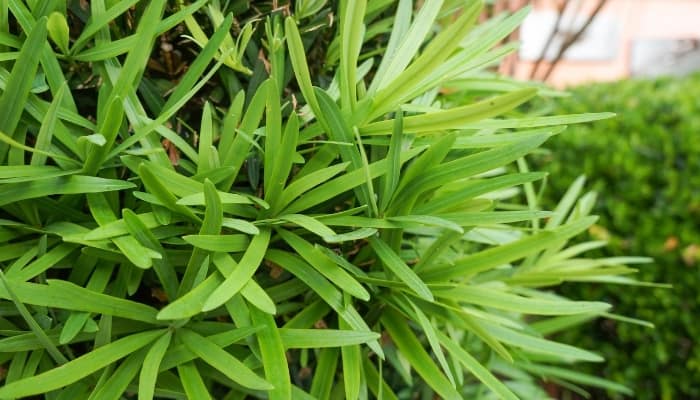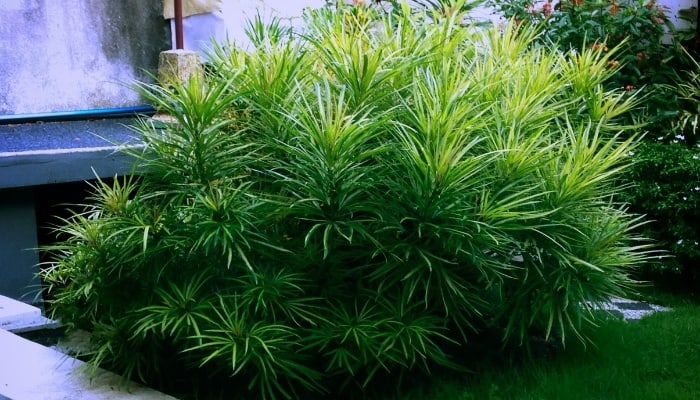The Podocarpus, also referred to as the plum pine, is a type of evergreen conifer that is capable of being cultivated as a shrub or a tree.
Depending on how it’s categorized, Podocarpus contains anywhere from 97 to 107 different species, so its characteristics can vary wildly depending on the species.
How fast does Podocarpus grow? Depending on the species, Podocarpus can be as small as 3 feet tall to up to well over 100 feet tall. Width varies greatly as well, some can be as narrow as 2 feet, and exceptionally large trees can be over 50 feet wide. Most of this will depend on the species of Podocarpus and where it’s grown.
With so many different species of Podocarpus, there’s a lot to learn about them.
Podocarpus Growth
As with most conifers, Podocarpus is a relatively fast-growing tree. It will grow anywhere from 12 to 36 inches per year, depending on the species and growing conditions.
While the tree is relatively fast growing, the shrub species tend to grow much more slowly, although growth rate depends greatly on the species and the plant’s growing conditions.
Podocarpus Size
Podocarpus will reach a mature height as short as 2 feet or well over 100 feet, depending on the species and growing conditions. Width varies just as greatly, anywhere from 3 feet to 50 feet or more.
Some notably large Podocarpus totara can have trunks up to 12 feet in diameter.
If you choose, Podocarpus can be kept as a bonsai as well. This goes to show that Podocarpus can grow as large or as small as you desire.
Podocarpus tend to grow tall in their early years, and as they reach their maximum height, they tend to widen, both at the trunk and through the fanning of their branches.
Popular Podocarpus
Podocarpus Hedge Growth Rate
Depending on the species, Podocarpus hedges will grow anywhere from 6 inches to over a foot per year. This makes Podocarpus hedges moderate-growth-rate plants.
Podocarpus Tree Growth Rate
As with most coniferous trees, Podocarpus is a relatively fast-growing tree with an annual growth rate between 1 and 3 feet.
The trees tend to grow tall in their early years and fan out as they age. Most won’t reach their full width until many years after they’ve reached their full height.
Factors That Affect Podocarpus Growth
There are many factors that can impact the growth of Podocarpus. The biggest ones are the amount of light they receive and their soil quality.
Podocarpus Spacing
Podocarpus should be planted 23 to 35 feet from anything that will impede its growth, depending on the type. Species that tend to be narrower can be planted closer together.
If you’re using it as a hedge, individual plants can be placed 3 feet from one another to create a dense Podocarpus hedge that is resistant to many common pests and diseases.
Amount of Light
Bright, direct light is best for Podocarpus to grow at its optimal rate, although it will still grow in a shady location, just more slowly. Expect Podocarpus grown in shade to have a deeper, richer color.
Soil Quality
Podocarpus accepts many types of soils, although it does not tolerate heavy, soggy soils well. For best results, find sandy, fast-draining soil, and keep it moist as regularly as possible.
Watering
Podocarpus requires moderately moist soil, but it is also relatively drought tolerant, especially in dense soils. Try to water Podocarpus regularly, keeping its soil moist but not overly wet.
Overly wet soil will lead to root rot, which, left unchecked, can kill your plant. When in doubt, it’s safer to keep your soil drier rather than wet.
Fertilization
For Podocarpus, 6-6-6 fertilizer is the most recommended, and the plant should be fertilized up to three times during the growing season.
Regular fertilization will allow Podocarpus to grow faster. If you desire a slower-growing plant, fertilizing less often will slow down its growth.
Pruning
Podocarpus tolerates pruning well. If growing as a hedge, it’s best to prune regularly to maintain the desired shape.
The more Podocarpus is pruned, the denser it will be. If allowed to grow freely, it has the chance to become leggy. Regular pruning will encourage Podocarpus to create a much more dense, full hedge.
Additionally, Podocarpus is often pruned into various shapes, cones, or columns. Prune in the early summer to allow your Podocarpus to recover from the pruning as effectively as possible.

How To Make Podocarpus Grow Faster
The best ways to encourage Podocarpus to grow faster are through regular fertilization, full sun, and proper soil.
The sun and fertilizer will give Podocarpus the nutrients and energy it needs to grow at its best, while the moist, well-draining soil will not cause stress on your plant, allowing it to use its energy for growth rather than stress reduction.
How To Make Podocarpus Grow Thicker
Many of the methods that encourage Podocarpus to grow faster are also essential for it to grow as thick as possible.
Combine those techniques with regular pruning of branches to encourage the plant to grow more densely and promote a full, thick hedge.
Podocarpus Problems
While relatively easy to grow, there are a few problems to which Podocarpus are susceptible. Watch out for the following issues:
Magnesium Deficiency
The sandy soil that Podocarpus prefers can often cause a magnesium deficiency, which will cause the leaves to turn yellow and the tips to develop necrosis.
Solution
Supplement with compost or Epsom salts.
Mites and Scale
Pests are rarely a concern for Podocarpus, but if there is an infestation, it can get out of hand easily.
Solution
A healthy plant will fight off small infestations of pests, but for larger infestations, a horticultural oil will be necessary to help the plant fight them off.
Related Questions:
Can Podocarpus Survive Winter?
Podocarpus grows best in warmer climates (USDA Zones 9 – 11). They prefer temperatures between 61 – 75 degrees Fahrenheit.
If you live where the temperature will drop below 55 degrees, it is best to have your Podocarpus planted in pots so you can bring them inside to weather the cold.
Can Podocarpus Be Kept Small?
Podocarpus are commonly kept as bonsai trees, so they can be kept quite small if desired.
If allowed to freely grow outside, Podocarpus will grow strongly, and if pruned to keep it small, it will tend to grow quite dense.
Regardless of whether you have a shrub or a tree, Podocarpus can grow to just about any size you choose.
Final Thoughts
There is a wide variety of Podocarpus to choose from. Whether you’re looking for a large shade tree or an evergreen shrub to be used as a dense hedge, there are many options from among the 100 or so species of Podocarpus.

